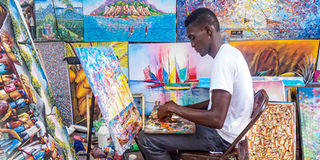The need to protect traditional visual artists from AI and ‘modern art’

What you need to know:
- While traditional visual artists bring immense value to their work, social media art appreciation is being overtaken by AI artists who invest nothing in their designs and have no emotional connection to their artworks.
Traditional visual arts, such as drawing, painting, photography, comic arts, cartoons, etc., are among the areas affected the most by Artificial Intelligence (AI) developments. Their artistic tracks are, by large, negatively affected because they now appear to be easy to create in a few minutes, which traditional artists would ordinarily work hard for. Aside from that, there is also a new trend of the hardly comprehensible form of art with a lot of money invested in it, yet lacking by large a reflection of what art really is. This is referred to as ‘modern art.’
With regard to AI, millions of images are created and circulated daily on the internet, social media, and even in print media. There is especially a new way of clout-chasing today where human stories are falsified behind the guise of AI images to generate traffic and engagement by appealing to the compassion, affection, and admiration of the viewers.
Many pages on social media publish AI images of older couples, asking people to congratulate them, children who have made strangely beautiful toys from plastic bottles or whatever material, appealing to people to congratulate them, etc.
While traditional visual artists bring immense value to their work, social media art appreciation is being overtaken by AI artists who invest nothing in their designs and have no emotional connection to their artworks. Traditional visual artists deserve more admiration and support than AI artists who are not personally involved in the production of the artworks.
Artworks are an important reflection of human thought and expression of the inner self. We admire artists, particularly because they patiently invest their time to entertain our perception with the beauty that flows from their inner faculties and minds. Art, in its totality, is merely an outer manifestation of a deeper, integrated inner reality. The world today treasures artists, even after many centuries, because their effort is seen in the beauty and depth their artworks represent.
Locally, we need to give traditional visual artists both a voice and a platform so that they can be heard more and more and also earn from their hard work and passion. The more platforms and voices these artists are given, the better the chance of preservation of their artistic styles, as young people will learn and get interested in engaging in traditional visual arts, which express real human conditions and perceptions. Beauty in artworks goes beyond the magnificence of images; it also has emotional and social dimensions, offering a sense of relatability to human feelings and conditions.
The new trend of modern art baffles the imagination of many people as well. Artworks like ‘Comedian,’ a banana duct-taped on the wall and sold for over $6 million; ‘Green White,’ sold for $1.6 million, being just a shape of solid green on a white background; and ‘Blood Red Mirror’ sold for $1 million, just as its name, a mirror painted red, fall into this controversial and shady category. For reasons beyond the imagination of many, this is where a lot of money is channelled. In most cases, the art aspect of these productions is invisible to many, and many consider them an insult to the proper trade of traditional visual arts.
There is a need to also encourage our people to love art and to admire and support our locally produced artworks. Special days can be created to nationally celebrate artists and support them, and also socio-political platforms can consider involving the local traditional artists. Though traditional art takes more effort and time, it is real, human, and meaningful.
Artists also need protection economically, especially by stringent copyright laws and enforcement, ensuring that their artworks are not stolen or copied without appropriate procedures. Our local museums and art galleries should also be more open to accommodating locally produced visual artworks. Practicing artists can also be engaged in our education system in a way that integrates theory and practical learning of who we are and what our artworks represent, even amidst the sociocultural richness of diversity.
On the other hand, foreign artworks need to be regulated to safeguard what we truly believe to be artistic on objective grounds. We would rather have a limited local collection than have a lot of incomprehensible visual art in public exhibitions. But still, we need more visual art museums around the country, if possible, in every district.
This will also help in terms of socio-cultural and historical relevance, as locals of that particular area can also have in the local museum artworks that reflect the cultures and traditions of the people. These are important art forms, as they spark not only admiration but also conversation. We need collective voice and action in supporting our local traditional visual artists and, of course, all other artists.
Shimbo Pastory is a Tanzanian advocate for positive social transformation and a student of Ateneo de Manila University, Manila, Philippines. Website: www.shimbopastory.com





